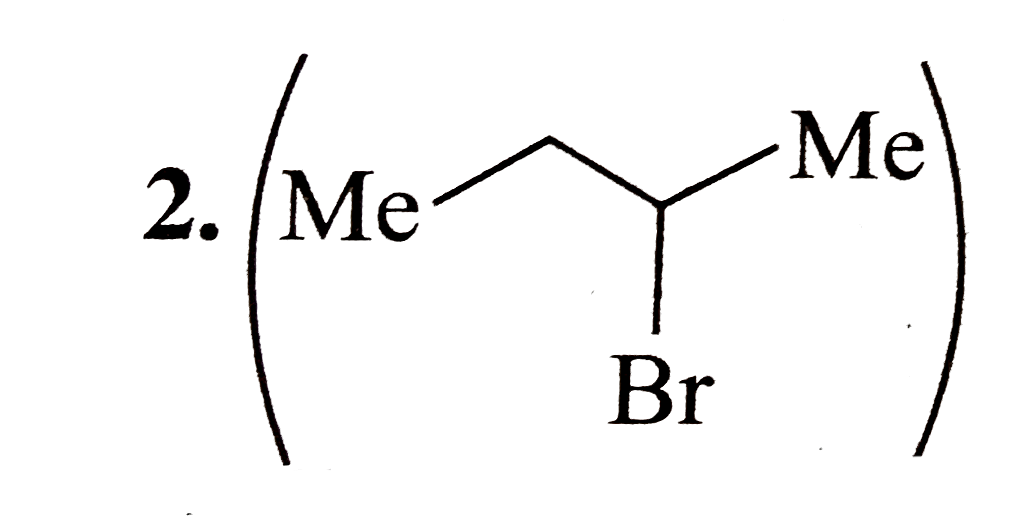Vinyl bromide undergoes :
Addition reaction
Substitution reaction
Elimination reaction
Rearrangement reaction
The correct Answer is:A, C
To determine the reactions that vinyl bromide (CH2=CHBr) can undergo, we will analyze each of the four types of reactions: addition, substitution, elimination, and rearrangement.
1. Identify the Structure of Vinyl Bromide:
- Vinyl bromide has the structure CH2=CHBr, which indicates it is an alkene due to the presence of a double bond between the two carbon atoms.
2. Addition Reaction:
- Vinyl bromide can undergo addition reactions. For example, when it reacts with hydrogen in the presence of a platinum catalyst, it adds across the double bond to form ethyl bromide (CH3CH2Br).
- Conclusion: Vinyl bromide undergoes addition reactions.
3. Substitution Reaction:
- In a substitution reaction, we would expect a nucleophile to replace the bromine atom. However, if vinyl bromide were to undergo an SN1 substitution, it would form a vinyl cation (CH2=CH+), which is unstable due to the sp-hybridized carbon's inability to stabilize the positive charge effectively.
- Conclusion: Vinyl bromide does not undergo substitution reactions.
4. Elimination Reaction:
- Vinyl bromide can also undergo elimination reactions. For instance, it can lose HBr to form acetylene (C2H2) through an elimination mechanism.
- Conclusion: Vinyl bromide undergoes elimination reactions.
5. Rearrangement Reaction:
- Rearrangement reactions typically involve the reorganization of the molecular structure to form a different isomer. However, vinyl bromide has only two carbon atoms, and there is no possibility for a rearrangement that would yield a different structure.
- Conclusion: Vinyl bromide does not undergo rearrangement reactions.
Final Summary:
- Vinyl bromide undergoes addition and elimination reactions.
- It does not undergo substitution or rearrangement reactions.
- Vinyl bromide has the structure CH2=CHBr, which indicates it is an alkene due to the presence of a double bond between the two carbon atoms.
- Vinyl bromide can undergo addition reactions. For example, when it reacts with hydrogen in the presence of a platinum catalyst, it adds across the double bond to form ethyl bromide (CH3CH2Br).
- Conclusion: Vinyl bromide undergoes addition reactions.
- In a substitution reaction, we would expect a nucleophile to replace the bromine atom. However, if vinyl bromide were to undergo an SN1 substitution, it would form a vinyl cation (CH2=CH+), which is unstable due to the sp-hybridized carbon's inability to stabilize the positive charge effectively.
- Conclusion: Vinyl bromide does not undergo substitution reactions.
- Vinyl bromide can also undergo elimination reactions. For instance, it can lose HBr to form acetylene (C2H2) through an elimination mechanism.
- Conclusion: Vinyl bromide undergoes elimination reactions.
- Rearrangement reactions typically involve the reorganization of the molecular structure to form a different isomer. However, vinyl bromide has only two carbon atoms, and there is no possibility for a rearrangement that would yield a different structure.
- Conclusion: Vinyl bromide does not undergo rearrangement reactions.
- Vinyl bromide undergoes addition and elimination reactions.
- It does not undergo substitution or rearrangement reactions.
Topper's Solved these Questions
- ORGANIC REACTION MECHANISMBOOK - CENGAGE CHEMISTRY ENGLISHCHAPTER - ORGANIC REACTION MECHANISMEXERCISE - Single correct
43 Videos
- ORGANIC REACTION MECHANISMBOOK - CENGAGE CHEMISTRY ENGLISHCHAPTER - ORGANIC REACTION MECHANISMEXERCISE - Assertion-Reasoning
12 Videos
- ORGANIC REACTION MECHANISMBOOK - CENGAGE CHEMISTRY ENGLISHCHAPTER - ORGANIC REACTION MECHANISMEXERCISE - Comprehension
35 Videos
- NCERT BASED EXERCISEBOOK - CENGAGE CHEMISTRY ENGLISHCHAPTER - NCERT BASED EXERCISEEXERCISE - Chemical Equilibrium
73 Videos
- P-BLOCK GROUP 13 - BORON FAMILYBOOK - CENGAGE CHEMISTRY ENGLISHCHAPTER - P-BLOCK GROUP 13 - BORON FAMILYEXERCISE - Exercise Archives (Subjecive)
9 Videos
Similar Questions
Neopentyl bromide undergoes dehydro halogenation to give alkene even though it has no β− hydrogen. This is due to :
View SolutionExplain :
a. Vinyl chloride is unreactive in nucliphillic 4− subsitution reactions.
b. Neopenthyl bromide undergoes nucliphillic substituion reactions very slowly.
c. 3− Bromocyclohexane is more reactive than 4− bromovyclohexane in hydrolysis with aqueous NaOH.
d. ter− Butyl chloride reacts with aqueous sodium hydroxide by SN1 mechanishm while n− butuyl chloride reacts by SN2 medchanism.
View Solution (sec-Butyl bromide) undergoes alkaline hydrolysis by :
(sec-Butyl bromide) undergoes alkaline hydrolysis by :
View Solution (sec-Butyl bromide) undergoes alkaline hydrolysis by :
(sec-Butyl bromide) undergoes alkaline hydrolysis by :
View SolutionWhich one of the following alkyl bromides undergoes most rapid solvolysis in methanol solution to give corresponding methyl ether?
View SolutionGive reason :
Lead bromide undergoes electrolytic dissociation in the molten state but is a non-electrolyte in the solid state.
View SolutionGive reasons for the following
Lead bromide undergoes electrolytic dissociation in the molten state but is a non-electrolyte in the solid state.
View SolutionEthyl iodide undergoes SN2 reaction faster than ethyl bromide.
View SolutionPropene reacts with HBr to give isopropyl bromide but does not give n-propyl bromide.
View SolutionAn alkyl bromide produces a single alkene when it reacts with sodium ethoxide and ethanol. This alkene undergoes hydrogenation and produces 2-methylbutane. What is the alkybromide ?
View Solution
